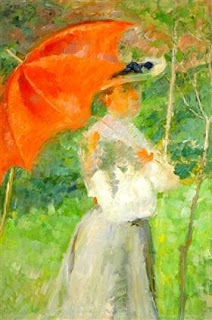I've been surfing through clouds of parasol photographs and I've found some really amazing examples. While many of the parasols I see are WHITE:
 |
| MFA 50.3161, dated early 20th century. Cute, this one has scalloped petal shapes! |
or BROWN:
 |
| MFA 50.3160, dated early 20th century. Boring color.. But the handle is carved to look like a thorny branch, kind of mimicking the burl handle on mine. |
or BLACK:
 |
| MFA 1987.330 about 1910-15 |
...There is far more variation to be found than initially meets the eye. Just look at these paintings, for starters!
 |
| Girl in red with a parasol, Max Pechstein, 1909 |
 |
| James R. Jackson, Dora with Parasol, 1917 |
 |
| Frederick Carl Frieseke, 1905, Lady with a Parasol |
 |
| Frederick Carl Frieseke, 1901, Luxembourg Gardens |
 |
| Richard E. Miller, unknown title or date, see http://www.tuttartpitturasculturapoesiamusica.com/2013/11/Richard-Emil-Miller.html |
 |
| The Parasol, Richard E. Miller, 1911-1913 |
 |
| Frederick Carl Frieseke, 1908, Lady with Parasol |
 |
| The Red Parasol, 1904, Matej Sternen |
 |
| Henri Lebasque, Promenade Sur L'Eau 1918 |
 |
| MFA The Green Parasol, John Singer Sargent, about 1911. Ooo these bluegreens are just the colors of my striped fabric... |
The predominant color of parasol in these paintings is red or green. I realize that those colors were likely chosen for their POP in the composition of the painting rather than their fashionability, and I concede that Light is the main concern of these artists, rather than Accuracy. However, I do think we can assume that red and green parasols (and striped versions of the same) existed at the time. Let's look at some fashion plates:
 |
| studio sketches, circa 1915-6, http://www.invaluable.com/auction-lot/four-lucile-studio-sketches,-circa-1915-6,-65b-c-8eb9eaae75 |
 |
| Journal des dames and des modes, 1912, I LOVE the polka dot parasol to match the dress! |
 |
| The Delineator, 1911 |
 |
| Godey Lady's Book, September 1890 (early edges of the range) |
 |
| 1913, http://www.bartoscollection.com/fp1913.html |
 |
| Delineator, July 1916, again a parasol that matches a skirt! :) Stripes! |
 |
| Journal des Dames et des Modes, 1914, great color |
 |
| Delineator, 1917, look how BOLD that purple and white one is... |
 |
| 1912 fashion plate from the Delineator. Colors! And layers of lace over color. |
Even better than general fashion plates are fashion plates devoted solely to parasols!! :D I found two of these:
 |
| Journal des Dames et des Modes, 1914, http://www.sil.si.edu/ImageGalaxy/imagegalaxy_imageDetail.cfm?id_image=11704 |
 |
| "Aux Galeries Lafayette" from damaged magazine, likely c1910, https://www.etsy.com/listing/126291988/vintage-french-fashion-plate-galeries?ref=shop_home_active |
And then of course there are photographs. Wonderfully for me, the first color photographs were being developed around this time, so we have some amazingly striking images to look at:
 |
| Flora Stieglitz Straus, by Nathan Straus, c. 1915. I was thinking that this image was fake, but then I found it linked to a legit Yale library! The problem is, it keeps getting attributed to another artist on pinterest... http://brbl-dl.library.yale.edu/vufind/Record/3525030 |
 |
| Mode aux courses, 1911-1914. STRIPES!! |
 |
| Peter Ivanovich Vedenisov, autochrome photograph, Russia, 1909-1914, http://www.vintag.es/2015/04/30-early-color-photographs-of-russia.html#more Amazing floral pattern.. |
 |
Peter Ivanovich Vedenisov, autochrome photograph, Russia, 1909-1914, what looks like blue on the outside and white on the inside!
 |
| Peter Ivanovich Vedenisov, autochrome photograph, Russia, 1909-1914 |
 |
| Woman with a parasol - Autochrome photograph by Antonin Personnaz, c. 1910. |
|
And last, but certainly not least, I have a spread of fabulous parasols at the MET to share:
All colors and patterns and stripes! Stripes! STRIPES!!
I feel sufficiently justified in using my blue and green striped fabric now :) I believe that what I am seeing is not some idiosyncratic fabric selection seen in one or two images. There is evidence of stripes and bold colors used for parasols in a broad selection of visual media of the era--paintings, fashion plates, photographs--and the extant "archaeological record" supports this impression.
Thus and
verily and
so we see and all that ;)






































No comments:
Post a Comment